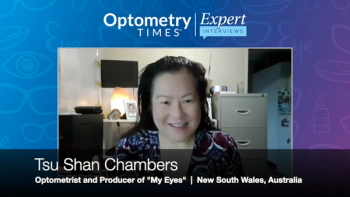
- June digital edition 2023
- Volume 15
- Issue 06
Comanagement of patients with keratoconus
Surgical interventions once disease progresses.
The most common type of corneal ectasia, keratoconus presents in adolescence and stabilizes during the third or fourth decade of adulthood.1,2 Patients can suffer mild to severe visual impairment from irregular astigmatism,
Although its prevalence varies, keratoconus is thought to be approximately 54 in 100,000, and to affect individuals of all biological sexes and all ethnicities.4-6 Patients present with blurred vision due to irregular astigmatism and/or coma, the most common higher-order aberration in this population.1,5 They often report decreased vision with spectacles and major changes in refraction that lead them to replace spectacles within a year of their last prescription.
Classifying the condition
Optometrists are often the first clinicians to interact with and diagnose these patients. Corneal topography is the primary diagnostic tool. The classic presentation is central or inferior steepening and thinning. Findings suggestive of keratoconus include astigmatism greater than 5 diopters (D), maximum keratometry readings greater than 49 D, and central corneal thickness of less than 470 µm.4
Both the Amsler-Krumeich classification method (which measures degree of refractive error, average anterior corneal curvature, corneal thickness at the thinnest location, and presence of scarring) and the Belin ABCD grading system (which analyses anterior and posterior radius of curvature, thinnest corneal thickness, and best corrected distance visual acuity) can be used to categorize disease severity.4 Scheimpflug tomography can also be used to examine the posterior surface of the cornea, which is often affected in keratoconus, and to detect early ectasia. Later stages of the condition will show anterior and posterior steepening.4,5
Mild: spectacles, soft lenses, CXL
Depending on severity, different options exist for the management of keratoconus. In the early stages, patients can use spectacles or soft contact lenses. Soft toric contact lenses are not often used because they do not address irregular astigmatism or higher-order aberrations. And although more custom options are available, such as lathed-cut soft lenses with quadrant-specific capabilities and greater central thickness, they too suffer from the same limitations. In general, soft lenses are used in milder forms of keratoconus or when the patient is unable to tolerate gas permeable (GP) lenses.5 Lens selection also depends on patient lifestyle and ability to care for the devices.
At initial diagnosis, corneal collagen crosslinking (CXL) should be considered because it halts disease progression and increases the cornea’s biomechanical properties,7-9 strengthening and stabilizing the collagen lamellae and promoting the formation of collagen bonds that stiffen the cornea, a process that occurs naturally with age.10,11
According to the Dresden protocol (the conventional CXL method), the central 7 to 9 mm of the corneal epithelium should be removed and the cornea soaked with a solution of 0.1% riboflavin-5-phosphate and 20% dextran every 5 minutes for a total of 30 and subsequently exposed to UVA radiation (370 nm, 3 mW/cm2)for another 30 minutes.2,10 Accelerated versions of the procedure can protect the deepithelialized cornea from infection and increase both patient comfort and treatment efficacy.2 There is also a transepithelial (epi-on) version of the procedure that is less painful and decreases the risk of complications caused by removing the epithelium. Traditional (epi-off) CXL, however, has been shown to result in a more regular corneal surface.12
CXL is indicated in patients whose disease progresses. There are a variety of different markers that can be used to measure progression, some of which include: an increase in anterior or posterior corneal curvature, change in manifest refraction, or decrease in corneal thickness.7,11 It is also recommended in young patients diagnosed at an early age and thus most likely to progress given that pediatric keratoconus often advances at a faster rate. These patients should consider undergoing CXL before significant progression has been observed.13
CXL is contraindicated if corneal thickness is less than 400 µm (to avoid UVA damage to the posterior cornea, anterior chamber, lens, and retina),14 if corneal scarring is present, or if there is prior/active herpetic eye infection. Patients who wore contact lenses before CXL will generally have to resume wearing them after the procedure. The success of CXL, which decreases the need for corneal transplantation,3 highlights the importance of early diagnosis, close monitoring, and prompt referrals.
Moderate: ICRSs, RGP lenses, hybrid lenses, piggybacking
Intracorneal ring segments (ICRSs) are made of polymethyl methacrylate and have an arc-shortening effect, thus altering the corneal lamellae and flattening the central cornea. They can be implanted during or beforeCXL and subsequently removed if needed.15 ICRSs may increase difficultly in fitting contact lenses because the entire cornea and ICRSs must be vaulted.
RGP lenses—which allow for the tear exchange between cornea and lens that neutralizes irregular astigmatism5—are the mainstay of corrective treatment for mildly to moderately conical corneas. Other options are the hybrid (RGP center surrounded by a soft lens skirt) and piggybacking (RGP lens atop soft lens) systems. Both combine the benefits of soft and rigid lenses and may be used to address poor adaptation to RGP lenses and lens decentration and ejection.
Severe: scleral lenses, corneal transplant
Scleral contact lenses (ScCLs) are RGP lenses whose diameter is larger, usually more than 15 mm, and that vault over the corneal apex and limbus. They land softly on the conjunctiva without blanching any of its blood vessels.5 ScCLs provide better visual performance and greater comfort to patients with various ocular surface disorders.16 They are more comfortable than RGP lenses because their edges don’t interact as much with the eyelids and they are more stable and centered. ScCLs are indicated in advanced keratoconus or if the patient has failed with previous lens designs, soft or corneal gas permeable, due to discomfort, poor fit, or poor vision.
Advances in the manufacturing of ScCLs allow for correction of both lenticular and/or corneal astigmatism. Front surface toricity to be added to correct residual lenticular astigmatism and for toric peripheral curves to be made if there is significant scleral toricity.5 One of the most important aspects of fitting is aligning the lens to the sclera to prevent compression, decrease fogging, and promote tear exchange. Toric peripheral curves can be beneficial when fitting ScCLs, as the sclera tends to increase in toricity as its distance from the limbus increases.17 In addition, correction for front surface eccentricity or wavefront aberration can be added to these lenses in the presence of higher-order aberrations.18 Some ScCLs feature quadrant-specific peripheral designs that address scleral asymmetry.5
Because ScCLs vault over the cornea, they can delay corneal transplants in eyes with minimal central scarring. In 1 study, 40 of 51 eyes with severe keratoconus were successfully treated with ScCLs and spared transplantation. Although this is partly due to the introduction of CXL, ScCLs reduce the lens intolerance and corneal scarring that may have indicated the need for corneal transplant surgery in the past.6
Ultimately, 10% to 20% of patients with keratoconus will need some type of corneal transplant.3 Corneal grafts are indicated in those who cannot tolerate lenses, have significant corneal scarring, are at risk of corneal perforation, or exhibit pronounced corneal thinning or protrusion that inhibits their ability to wear lenses.5
Penetrating keratoplasty (PK) removes the entirety of the cornea and replaces it with donor tissue. Deep anterior lamellar keratoplasty (DALK) removes the epithelium and stroma, leaving Descemet’s membrane and endothelium intact and thus helping to maintain ocular integrity, eliminate risk of endothelial cell rejection, and prolong graft life. Although DALK offers faster recovery and visual improvement, patients who undergo PK may achieve better visual acuity in the long run.12
Conclusion
A number of options exist for managing the various stages of keratoconus. At diagnosis—or at first sign of progression—young patients should be referred for CXL. Patients who previously worse lenses will most likely require post-procedure refitting. The severity of the condition may dictate the type of lens used: soft, specialty soft, hybrid, piggyback, RGP, or ScCL. When the patient can no longer tolerate lenses or there is significant corneal scarring, a corneal transplant is needed, be it DALK or PK. Even after partial or total transplantation, patients can continue to be comanaged and may still require contact lenses.
References
1. Shneor E, Millodot M, Blumberg S, Ortenberg I, Behrman S, Gordon-Shaag A. Characteristics of 244 patients with keratoconus seen in an optometric contact lens practice. Clin Exp Optom. 2013;96(2):219-224. doi:10.1111/cxo.12005
2. Kymionis GD, Kontadakis GA, Hashemi KK. Accelerated versus conventional corneal crosslinking for refractive instability: an update. Curr Opin Ophthalmol. 2017;28(4):343-347. doi:10.1097/ICU.0000000000000375
3. Godefrooij DA, Gans R, Imhof SM, Wisse RPL. Nationwide reduction in the number of corneal transplantations for keratoconus following the implementation of cross-linking. Acta Ophthalmol. 2016;94(7):675-678. doi:10.1111/aos.13095
4. Mas Tur V, MacGregor C, Jayaswal R, O’Brart D, Maycock N. A review of keratoconus: diagnosis, pathophysiology, and genetics. Surv Ophthalmol. 2017;62(6):770-783. doi:10.1016/j.survophthal.2017.06.009
5. Downie LE, Lindsay RG. Contact lens management of keratoconus. Clin Exp Optom. 2015;98(4):299-311. doi:10.1111/cxo.12300
6. Koppen C, Kreps EO, Anthonissen L, Van Hoey M, Dhubhghaill SN, Vermeulen L. Scleral Lenses Reduce the Need for Corneal Transplants in Severe Keratoconus. Am J Ophthalmol. 2018;185:43-47. doi:10.1016/j.ajo.2017.10.022
7. Tiveron MC Jr, Pena CRK, Hida RY, Moreira LB, Branco FRE, Kara-Junior N. Topographic outcomes after corneal collagen crosslinking in progressive keratoconus: 1-year follow-up. Arq Bras Oftalmol. 2017;80(2):93-96. doi:10.5935/0004-2749.20170023
8. Tian M, Ma P, Zhou W, Feng J, Mu G. Outcomes of corneal crosslinking for central and paracentral keratoconus. Medicine (Baltimore). 2017;96(10):e6247. doi:10.1097/MD.0000000000006247
9. Kasai K, Kato N, Konomi K, Shinzawa M, Shimazaki J. Flattening effect of corneal cross-linking depends on the preoperative severity of keratoconus. Medicine (Baltimore). 2017;96(40):e8160. doi:10.1097/MD.0000000000008160
10. Sorkin N, Varssano D. Corneal collagen crosslinking: a systematic review. Ophthalmologica. 2014;232(1):10-27. doi:10.1159/000357979
11. Hersh PS, Stulting RD, Muller D, Durrie DS, Rajpal RK; United States Multicenter Clinical Trial of Corneal Collagen Crosslinking for Keratoconus Treatment. Ophthalmology. 2017;124(9):1259-1270. doi:10.1016/j.ophtha.2017.03.052
12. Santodomingo-Rubido J, Carracedo G, Suzaki A, Villa-Collar C, Vincent SJ, Wolffsohn JS. Keratoconus: an updated review. Cont Lens Anterior Eye. 2022;45(3):101559. doi:10.1016/j.clae.2021.101559
13. Brown SE, Simmasalam R, Antonova N, Gadaria N, Asbell PA. Progression in keratoconus and the effect of corneal cross-linking on progression. Eye Contact Lens. 2014;40(6):331-338. doi:10.1097/ICL.0000000000000085
14. Kymionis GD, Portaliou DM, Diakonis VF, Kounis GA, Panagopoulou SI, Grentzelos MA. Corneal collagen cross-linking with riboflavin and ultraviolet-A irradiation in patients with thin corneas. Am J Ophthalmol. 2012;153(1):24-28. doi:10.1016/j.ajo.2011.05.036
15. Barbara R, Barbara A, Naftali M. Depth evaluation of intended vs actual intacs intrastromal ring segments using optical coherence tomography. Eye (Lond). 2016;30(1):102-110. doi:10.1038/eye.2015.202
16. Otchere H, Jones LW, Sorbara L. Effect of time on scleral lens settling and change in corneal clearance. Optom Vis Sci. 2017;94(9):908-913. doi:10.1097/OPX.0000000000001111
17. Visser ES, Soeters N, Tahzib NG. Scleral lens tolerance after corneal cross-linking for keratoconus. Optom Vis Sci. 2015;92(3):318-323. doi:10.1097/OPX.0000000000000515
18. Rathi VM, Mandathara PS, Taneja M, Dumpati S, Sangwan VS. Scleral lens for keratoconus: technology update. Clin Ophthalmol. 2015;9:2013-2018. doi:10.2147/OPTH.S52483
Articles in this issue
over 2 years ago
The role of nutrition in myopia controlover 2 years ago
ASCRS 2023 innovation highlightsover 2 years ago
Reading the greens: Golf, vision, and nutritionover 2 years ago
Keeping an eye on geographic atrophyover 2 years ago
Into the periphery with lattice retinal degenerationover 2 years ago
A funny thing happened at the office: Part 2over 2 years ago
Stating the facts about combination myopia management treatmentsNewsletter
Want more insights like this? Subscribe to Optometry Times and get clinical pearls and practice tips delivered straight to your inbox.



















































.png)


